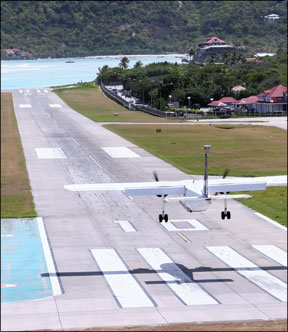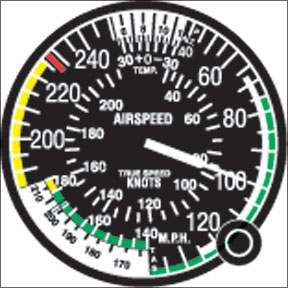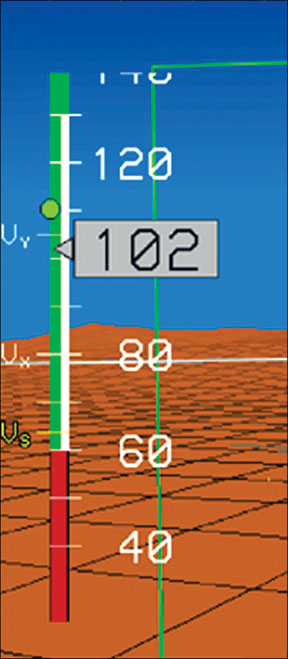So much of operating personal aircraft is a numbers game: How many gallons of fuel are required, how many inches aft is the center of gravity and how many more minutes until we arrive? The automation available in todays avionics makes some of this childs play, but we still need to know how to do the basic computations, if for no other reason than the day our expensive panel soils the bed. The same is true for just basic stick and rudder skills, also. For example, there are several performance airspeeds that, when the need arises, youve got to be able to predictably attain. 288 Some may be obvious, others perhaps not, and some reference speeds well address a little differently than you might have been taught. Unfortunately, recent NTSB accident histories show a growing trend away from proper airspeed control, so with that in mind, lets review five speeds youve got to nail. Best Angle of Climb One of the most critical airspeeds to predictably attain is VX, best angle of climb speed. If you need to clear a real obstacle, its vital you know how to get best-angle performance. Best angle of climb results when you match the maximum available power with the pitch attitude that results in the greatest amount of lift. This will be necessarily close to the power-on stall attitude-most wing designs develop progressively more lift with increases in angle of attack almost right up to the angle where airflow burbles and the wing begins to stall. Without angle-of-attack meters in virtually all general aviation airplanes, were left with an indicated airspeed thats approximately the optimal VX attitude. The VX speed is published at maximum gross weight in most flight manuals. Some manuals will include different recommended VX speeds (sometimes identified as a 50-foot agl target on takeoff performance charts). As weight goes, down so does VX speed, because at reduced rates the airplane can sustain flight at a lower indicated airspeed without exceeding the critical angle of attack. But most handbooks wont tell you VX increases as the airplane climbs. This is because less lift is generated in thinner air, requiring the airplane fly at a slightly lower angle of attack to avoid a stall. Best rate of climb speed, conversely, reduces with altitude because available power reduces with power as well-even turbocharged engines lose propeller efficiency in thinner air-and with less surplus power it takes a higher angle of attack to generate the greatest available climb rate. From its sea-level starting point (based on airplane weight), VX will gradually increase until it intersects the decreasing VY slope at that airplanes absolute altitude…where it can no longer climb at all. Theres a school of thought that all takeoffs should begin with a VX climb until reaching some height above the ground, then transitioning to VY or a cruise climb attitude. The reasoning behind the initial VX phase is usually that this gives the airplane the greatest altitude in the event of an engine failure for any given amount of time after liftoff. Consequently, the argument goes, the pilot has a greater number of options available. History shows, however, that if an engine failure on takeoff gets someone, its almost always a stall or loss of control that leads to injury or death. Single-engine mishaps tend to be stalls after engine failure, while twins tend toward loss of 288 control and VMC rolls. Controlled flight straight ahead is almost always survivable unless terrain or obstacles conspire against us. Climbing steeply in a VX attitude means airspeed will very quickly deteriorate if power fails. So unless a VX climbout is necessary to clear obstacles or to net a required climb gradient, theres a much greater margin of safety when climbing at VY or, especially in piston twins, even faster. When making any VX departure, you should consciously brief yourself that you need to push hard forward on the controls at the first sign of a power reduction on takeoff. Remember that a VX takeoff requires pulling the airplane positively to the best-angle climb attitude on liftoff-theres no simply letting the airplane become airborne “when its ready to fly” if youre trying to clear an obstacle close to the departure end. If your airplane is at maximum gross weight and youre taking off at a sea-level density altitude, follow the “book” numbers. If your POH gives different speeds based on takeoff weight and youre departing at a sea-level density altitude, fly the weight-appropriate speed. But if youre departing from a high-density-altitude airport, fly VX a little faster than “book,” but still less than published VY, to get the desired performance. This is another way of saying you must give yourself a greater margin for safety at high density altitudes, because the POH usually doesnt tell everything you need to know to get maximum available performance. Regardless of the variables, if the situation calls for a VX takeoff, its vital you nail the proper speed to net best-angle performance. Cruise Climb Another speed, VCC, or cruise-climb airspeed, may or may not be defined in your aircrafts data. Depending on the nature of the airplane youre flying, you may need to choose a VCC different from what the “book” may suggest anyway. Your cruise-climb speed will depend on three main variables: climb gradient, forward visibility and engine temperatures. Regardless of other considerations, most obviously your climb speed needs to result in a rate of climb that permits you to avoid any obstacles, or to climb swiftly through holes between threatening clouds to remain in VMC if youre not on an IFR clearance or if hazards within the clouds make visual avoidance prudent. In many airplanes, the “book” climb speed results in an attitude that obstructs forward vision. Lowering the nose even only a couple of degrees can vastly improve forward visibility for traffic, terrain and weather avoidance. And engine temperature management is usually the prime determinant of VCC, assuming all other goals have been met. Many high-power and turbocharged powerplants will overheat if climbed extensively in hot-weather conditions. You may find there is very little vertical speed penalty for climbing at a speed many knots greater than “book” cruise-climb speed. To achieve the desired climb gradient, and ensure forward visibility and acceptable engine temperatures you may have to consistently nail a cruise-climb speed. Turbulent Air Turbulent air penetration speed is one of the least commonly understood critical airspeeds for three reasons. First, many pilots have an incorrect perception of why turbulent air penetration speed is important. Too, pilots have little guidance on when it is necessary to slow down for turbulence. Finally, POHs and other flight manuals dont spell out techniques for using “rough air” speeds. Pilots on the whole are a macho lot, and some may think they dont need to slow down because they can “handle” the bumps. Turbulent air penetration speed is about aerodynamics, 164 not comfort, however; the pilots ability doesnt enter into the equation VA = VS times the square root of the limit load factor. Generally pilots are taught that turbulent air penetration speed is identified as VA, and as such it is found in the Limitations and Normal Procedures sections of GAMA-format flight handbooks. Some POHs also separately define a turbulent air penetration speed that usually equals the published VA. The gold-standard text Aerodynamics for Naval Aviators defines VA as “the minimum airspeed at which the limit load could be developed aerodynamically.” It goes on to say, “any airspeed greater than VA provides a positive lift capability sufficient to damage the airplane.” Fly slower than VA and theres nothing you can do with the flight controls to exceed airframe structural limits. (Were talking about instantaneous effects here; of course, if you use the flight controls to put the airplane in an attitude that increases G-load, the load can then exceed the design limit.) At speeds above VA, an abrupt control input alone can cause damaging flight loads. By definition, VA is all about the effect of making rapid control inputs. Abrupt control movement may be part of the pilots natural response to turbulence, but its also possible to fly from perfectly smooth air into a shear that creates significant turbulence without radically moving the controls. There is likely a maximum indicated airspeed, then, for flight in turbulence that is not strictly defined by VA. In fact, many airplanes come with a flight manual recommendation called the turbulent air penetration speed, sometimes called VB or VRA (“velocity for rough air”). VB is the design speed for maximum gust intensity…but the speed itself is not strictly defined. The FAAs FAR 25.335 calls this the recommended speed for maximum gust intensity, or VB. This speed must not be less than stalling speed, but otherwise “may be chosen to provide an optimum margin below low and high-speed buffet boundaries.” So, VB then is a target “rough air” speed (sometimes called VRA) and is not usually defined for non-transport category airplanes, which are not certificated under FAR Part 25, however. Instead, VA may be the only guidance youve got. When to slow down, meanwhile, is one trick were not usually taught. The purpose of slowing down is to prevent being bumped with a force that will exceed aircraft limit stresses. If you wait until hitting that first “moderate” or “severe” bump, then youve already potentially damaged the aircraft structure. So you need to slow to turbulent air penetration speed before you encounter turbulence. This means proactively reducing speed when you see youll enter cumulus clouds, or fly close to ridge lines, or through inversions or in areas of strong surface winds, and when descending from cruise flight. Recently our online sister publication AVweb.com featured interviews with WWII pilots on instrument flying in that era. One veteran pilot commented they routinely flew a lot closer to (and even into) thunderstorms than is considered survivable today, but the biggest difference was that pilots then slowed down a lot more before entering those conditions. For the airplanes we fly, VA is a defined certification speed. It does not vary simply because by definition it assumes maximum gross weight. The effect of VA, however, does change with a reduction in airplane weight, because a lighter airplane will be more forcefully impacted by a given gust. Most POHs give no guidance on reducing VA or identify VA at reduced weights, but a generally accepted rule of thumb for airplanes weighing less than 12,500 pounds is to reduce published VA by about two knots for every 100 pounds below maximum gross weight (MGW) at the time of a turbulence encounter. A 3600-pound MGW airplane with a published VA of 140 KIAS, for instance, would have an “effective VA” of about 132 KIAS at 3200 pounds. Should VA, adjusted for weight, be your target airspeed for preparing for a turbulence encounter? Remember the object is to fly slowly enough that you avoid overstressing the airframe. Quite frequently in turbulence, airspeed will fluctuate significantly. To avoid structural failure, you must fly at a speed where the maximum speed encountered in gusts is at or below the adjusted VA speed. In practice, your target turbulent air penetration speed should be 10 to 15 knots slower than VA. Its critical you choose to slow down before encountering the first big bump, and that you be able to predictably nail a “rough air” speed ensuring maximum airspeed deviations remain below the weight-adjusted VA speed. Final Approach Just as how VX is vital for taking off over an obstacle, so too is it important to fly the proper speed for landing-VREF, the 95 landing reference speed. Most POHs give a target final approach speed on the landing performance chart. Like takeoff charts, the one for landing performance may give a series of VREF speeds for differing airplane weights, and in some cases youll find multiple charts based on differences in landing flap extension, each with different VREF speeds. Like other target speeds, VREF is actually an approximation of an optimal angle of attack and, therefore, it will vary downward with decreased airplane weight, and upward slightly with increases in density altitude. Fly too slowly and drag may actually be greater, sometimes significantly so; sink rates will increase. Five knots below reference speed on a short-field landing and descent rate may be so great you cant stop it in a flare when you reach the runway. Excess speed means momentum, too. A rule of thumb holding true for many light aircraft is that every additional five knots over VREF for the airplanes weight will increase the landing distance by about 10 percent. Gust protection considerations aside, a few extra knots each for the wife and your several kids may actually make the landing less safe, especially if the runway is short or youre already landing long for some reason. Consequently, to safely clear obstacles, retain the control authority to flare, and to consistently hit your runway aim point, its essential you nail the landing VREF speed. Minimum Descent Heres another one of the POH speeds instructors dont seem to spend much time on, and pilots consequently do not often consider. Lose an engine in flight (assuming a single-engine airplane) and weve been drilled to hit best glide speed. This is required if your emergency landing spot is some distance away from the airplane; since best glide is one of the speeds so frequently stressed in initial, airplane checkout and flight review training, it shouldnt be necessary to review that requirement here. But once youve made it to above that field, or if a perfectly good airport is almost directly beneath you and you want to maximize the time available to radio for help or prepare the airplane and passengers for an emergency landing, theres another, slower speed thats more appropriate. Sometimes called VMINIMUM DESCENT, VEMERGENCY LANDING or some similar name, VMD is to descents as VX is to takeoffs, while “best glide” is analogous to “best rate” climb speed. Flying at VMD gives you what you may need the most if an engine quits: time to react, troubleshoot and prepare. Its a good bit slower than best glide speed, reducing dramatically the impact forces youll need to endure if you dont have a smooth surface for touchdown. It also by design ensures you have control authority to arrest the rate of descent-VMD is a little higher than landing VREF because in most propeller planes even when the throttle(s) is/are at idle, theres additional airflow over the elevator from prop blast. Coming in to land without power, then, its crucial to attain minimum descent airspeed before touching down. Nailing It We all try to fly with as much precision as possible. There are times when precision, however, is not a luxury. Without fail, those occasions also are the times when we are least able to pull out the POH, page through it and find what were looking for. There are some airspeeds you have to nail to achieve the highest levels of safety and performance. These five will help you through most situations we can imagine. It might be a good idea to take a moment or two, research them for your airplane at typical weights, and make a small chart or memory aid you can stick to the instrument panel, or clip to your kneeboard.







